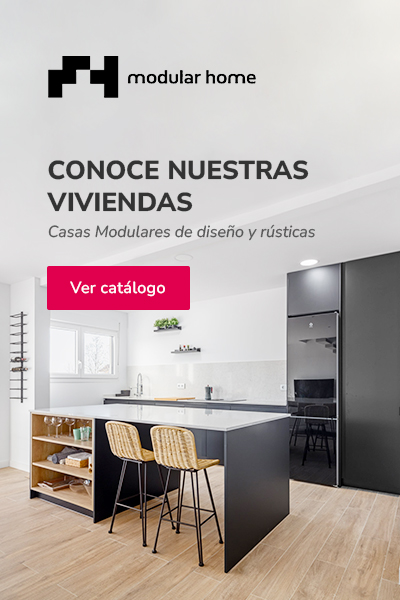In our Blog we have presented the seven steps to build your house. Last week, without going any further, we talked to you about the exterior spaces in Architecture. And on other occasions the topic has been about the Modular Home design houses. In short, we are giving you clues and advice about building your own house. Obviously we want you to choose us as partners to build your home. But beyond ourselves, you can use all these tips without having to count on us. Today we continue in that line and bring you some recommendations to design your home.
Design your house, some recommendations
If there was a magic or infallible formula to design your house, we wouldn't be here writing about it. This is so that formula would already be in the public domain and there would be nothing more to talk about. Even though it does not exist, it is true that there are a series of points to attend to. In such a way that we know what to count on to make a good construction design. For this reason, we must know the basic recommendations on which to focus design decisions. On very few occasions we will be able to attend to all of them 100%. It is at that point that the designer must prioritize to find the perfect balance.
Recommendations on issues such as orientation of your house. The efficient use of crossed ventilation. Interior partitions that respect the 90º angle. Differentiation of the time zones. Special attention to wet rooms, kitchen and bathrooms. Pampering the details of bedrooms and rest-leisure areas. And of course emphasize the Energy Efficiency .
 Energy efficiency
Energy efficiency
Many people may think what energy efficiency has to do with design. The truth is that a lot, especially if we think about making or building our own house. If we are going to purchase a second-hand home, this recommendation may not have much to do with the design. Let's see what issues related to energy efficiency we should keep in mind when designing your home.
The façade or enclosure, material used in its construction. We have already told you that without a doubt reinforced concrete is one of the best allies in this company. Another protagonist that we must take into account is the thermal isolation. Here we must know the different types and thicknesses to use. The exterior carpentry, windows and access doors. Not only their material, but their location and dimensions are very important. Others sun protection elements. From the blinds, the eaves of the construction itself...
The type of heating installation chosen one. The boiler and radiators chosen, as well as the distribution of elements. Take into account the boiler consumption, both for heating and for the production of domestic hot water. To balance all these issues there is what we know as an energy efficiency certificate. All newly built homes are required to have it. And in the case of buying and selling second-hand homes, it is a mandatory document on the part of the seller.
 The orientation of our house
The orientation of our house
Continuing with energy efficiency as a fundamental issue in design, we remember the importance of orientation. The orientation of your house will define whether it is bright and warm. Thus, the rooms that we are going to use mostly during the day should be oriented to the South. For example, the master bedroom tends to face west to capture as much heat as possible through the openings in the façade. Of course, this orientation must be studied with the geographical location of the house.
Because the geographical location will determine the summer sunshine, and the length of time each season lasts. For children's rooms, the East orientation is the most advisable. Waking up to sunlight streaming into your room is truly a blessing. Areas of discontinuous uses from communication centers to bathrooms and storage spaces can be oriented to the North.
 La Crossed ventilation
La Crossed ventilation
And we finish with cross ventilation. It is more than proven that being able to conveniently ventilate your home is essential for its comfort. Facing facades will help us with this need. With ten minutes of daily ventilation the stale air inside will be renewed. Be careful not to spend more than that time because we can cool the walls of our home too much.
Day and night use areas
When designing your house you must consider the differentiation between night and day areas. The use of the rooms has a lot to do with the day. Our body ends up getting used to the fact that something different is practiced in each area. By use we could divide the day rooms such as the living room, kitchen, bathrooms, halls... The night rooms, bedrooms and some bathrooms. For the night area, a recommendation is that they be as far away as possible from common areas and entrances.
The bedrooms
Recommendations about bedrooms, for example that access to them be through the foot of the beds. Where the headboard of the bed rests must be a uniform plane, without projections such as structure or installation bumps. When a bedroom partition shares a surface with a wet room, placing a built-in wardrobe in it will reduce noise transmission.
The kitchen
Special attention to the walls that may contain the kitchen cabinets. That there are no impediments to furnishing, gaps such as doors or windows, and gaps in structure or facilities. Remember the need to have a sufficient countertop surface to be able to work. There is a kitchen design rule that talks about the location of the “holy trinity” of the kitchen in relation to each other. It is none other than the refrigerator, cooktop and sink. The distance between these three elements must be between 1,2 and 2,7 meters.
The bathrooms
The layout and orientation of the sanitary fixtures is the most important thing to take into account when designing the bathroom. As a general rule, the sink is the first one we should place when opening the door. A correct bathroom surface is one that allows you to wash your hands and not need to close the door. The door is an element that we must use to maintain privacy when using the shower or toilet.
The living room
Sometimes, due to the surface possibilities we have, we can have separate rooms for these two uses. It would certainly be ideal, but sometimes the same room has to have both uses. The location of power outlets and TV outlets will determine the location of the different furniture. It will always be easier to decorate surfaces in rectangular plants, in such a way that we could divide the dining and living room area into two.
Another fundamental issue is the distance between our eyes and the television. It is true that televisions are getting better and better and their impact on our eyes is less. But over time the size of the screens we use has increased. Therefore, the distance of three meters is still more than recommended. Thus, if we have two walls facing each other, and we place the television on one and the sofa on the other, these walls must be separated by at least three and a half meters.
The 90º of the walls and facades
Surely this recommendation will not be understood that way at first. Let's think that 90º angles or right angles are the most used in furniture. From the beds, the shelves, stackable... When the partition has other angles, the decoration of these surfaces is impossible. And what can we say about the curved walls. As an architectural resource it is very useful, but only outside the walls. Intramuros living with those "geniuses" is a losing battle.











